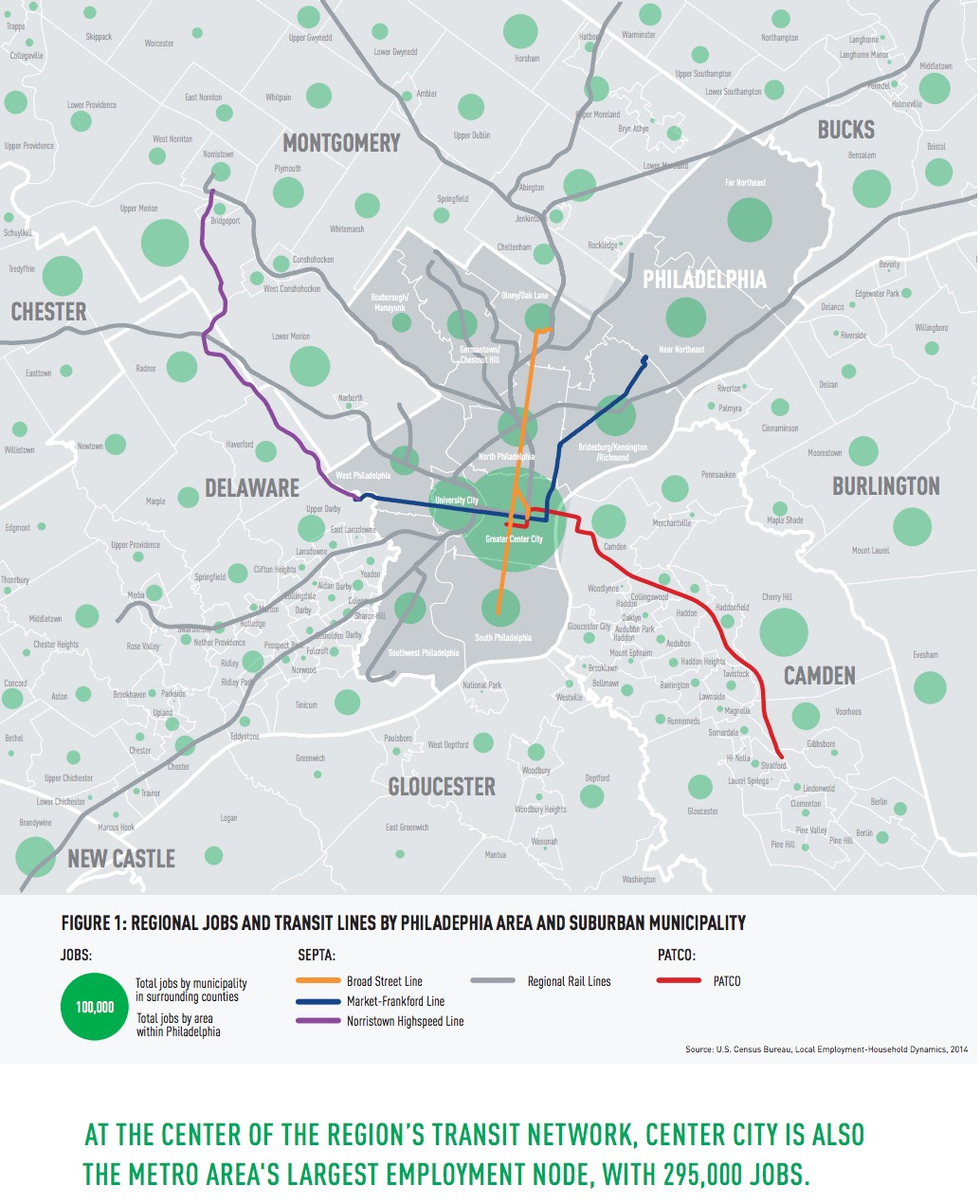CENTER CITY DISTRICT
GETTING TO WORK: TRANSIT, DENSITY & OPPORTUNITY
Center City Philadelphia, located at the center of the region’s transit network, holds the largest concentration of employment anywhere in the metro area, with 295,000 jobs. More than 1 million residents of surrounding suburban counties live within one mile of a rail station, connecting them directly to downtown’s employers, retail shops, restaurants, educational, medical, arts and cultural institutions. Fifty percent (50%) of city residents can commute by transit to Center City in 30 minutes or less; 61% of those who live in Greater Center City can get to City Hall (the geographic center of downtown) in 15 minutes or less. Center City’s transit connectivity is particularly important to the substantial number of lower-income Philadelphia residents who do not own cars.
Job Density and Transit
Transit is not just a convenience; it is essential to the density that enables Center City to provide 42% of all jobs in Philadelphia. If downtown workers relied on cars to the same degree as commuters across the region, then 295,000 workers would arrive each day in 227,150 cars. At 330 square feet per parking space, we would need a giant, surface parking lot of 2.6 square miles – larger than William Penn’s original plan for the city (2.2 square miles river to river, Vine to South) – leaving little room for the office buildings, hotels, hospitals, universities, residences, cultural institutions, historic destinations, restaurants, retail shops and parks that define the diversity and create employment opportunities downtown. Instead, SEPTA rail, subway, trolley and bus lines converge with PATCO and NJ Transit from New Jersey to deliver 290,000 workers, students, visitors, shoppers and patients each weekday into Center City.
Center City employers benefit not just from a multi-modal transit system, but also from the rapidly growing, live-work neighborhoods that are expanding around the downtown core. While just 10% of downtown jobs are held by Greater Center City residents, the percentage of downtown residents with a BA degree or higher is 58%, nearly twice the regional rate of 34%. This critical mass of talent is positively impacting business-location decisions. Another 41% of downtown jobs are held by residents of city neighborhoods, north of Girard Avenue, south of Tasker Street and west of the Schuylkill River; 39% are held by residents of the suburban counties surrounding Philadelphia.
Getting to Work, Greater Center City
Residents of Greater Center City enjoy the most commuting alternatives and rely the least on cars (Figure 6). Because 40% work in Center City (the highest live/work ratio in the city and region) and another 12% work in University City, 60% get to work without a car. By contrast, 60% of the residents of the balance of Philadelphia and 80% of the residents of surrounding counties depend on cars for their daily commute.
In Greater Center City, the closer one lives to the core, within the pre-automobile street-grid established in the 17th and 18th centuries, the lower the dependency on a car for commuting (Figure 5). In the neighborhoods of Rittenhouse Square, Chinatown, Washington Square, and Logan Square, more people walk to work than drive (Figure 4). In almost all of Greater Center City, the majority of commuters get to work by means other than a car; the only exceptions are neighborhoods at the periphery, along I-76 and I-95, like Grays Ferry, Pennsport, the Waterfront and Northern Liberties. Overall, Center City has the lowest reverse-commute rate to the suburbs (24%) of any portion of Philadelphia.
Getting to Work, City and Region
Beyond the downtown core, auto-free commuting is possible along subway and trolley lines that were extended in the early 20th century into Lower North, West, South, and Southwest Philadelphia (Figure 7). In those areas, more than half of workers reach their job without using a car. The Regional Rail lines, particularly in Northwest Philadelphia, provide good connectivity as well to Center City and University City. Outside of Philadelphia, most of the carfree commuters are also living along regional rail lines – particularly the Paoli/Thorndale and Media/Elwyn Lines, the Norristown High Speed Line, and PATCO.
In the balance of the neighborhoods of Philadelphia outside Greater Center City, an average of 25% of workers commute to jobs in Center City; another 6% work in University City. In all these neighborhoods, more people work downtown than they do in the area in which they live (the citywide average live/work ratio is 12%, Figure 9). But 39% of city residents who live outside Greater Center City commute to jobs outside the city and are highly dependent on cars.
Download full version (PDF): Transit, Density and Opportunity
About the Center City District
centercityphila.org
The Center City District (CCD) and Central Philadelphia Development Corporation (CPDC) share a common mission: to enhance the vitality of Center City Philadelphia as a thriving 24-hour downtown and a great place to live, work or have fun. The Central Philadelphia Transportation Management Association (CPTMA) works to make travel within Center City efficient, reliable, pleasant and safe.
Tags: CCD, Center City District, Central Philadelphia Development Corporation, Central Philadelphia Transportation Management Association, CPDC, CPTMA, PA, Pennsylvania, Philadelphia







 RSS Feed
RSS Feed